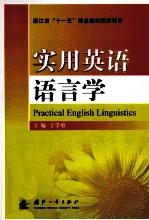

实用英语语言学PDF电子书下载
- 电子书积分:12 积分如何计算积分?
- 作 者:于学勇主编
- 出 版 社:北京:国防工业出版社
- 出版年份:2011
- ISBN:9787118075311
- 页数:302 页
Chapter 1 Linguistics and Language 1
1.1 What is Linguistics? 1
1.1.1 Definition of Linguistics 1
1.1.2 The Process of Linguistic Study 2
1.1.3 The Scope of Linguistics 3
1.1.4 Important Distinctions in Linguistics 5
1.2 Language 13
1.2.1 Why Study Language? 13
1.2.2 What is Language? 14
1.2.3 Design Features of Language 16
1.2.4 Functions of Language 19
Exercises 23
Further Reading 24
References 25
Chapter 2 Speech Sounds 26
2.1 Phonetics 26
2.1.1 What is Phonetics? 26
2.1.2 Speech Organs 27
2.1.3 Segments,Divergences,and Phonetic Transcription 29
2.1.4 Classification of English Speech Sounds 31
2.2 Phonology 36
2.2.1 What is phonology? 36
2.2.2 Phone,Phoneme,and Allophone 38
2.2.3 Phonemic Contrast,Complementary Distribution,and Minimal Pair 39
2.2.4 Some Rules in Phonology 39
2.2.5 Suprasegmental Features 41
Exercises 47
Further Reading 47
References 47
Chapter 3 Morphology 49
3.1 What is Morphology? 49
3.1.1 Morpheme 50
3.1.2 Morphemes and Syllables 52
3.1.3 Types of Morphemes 53
3.2 What is Word? 56
3.2.1 Word Class 58
3.2.2 Word Formation Process 62
3.2.3 Collocation 69
Exercises 70
Further Reading 72
References 72
Chapter 4 Syntax 73
4.1 What is Syntax? 73
4.1.1 Word-level Categories 74
4.1.2 Phrase Categories 76
4.1.3 Phrase Structure Rule 76
4.1.4 Sentences(The S rule) 80
4.2 The Process of Syntax 82
4.2.1 The Traditional Approach 82
4.2.2 The Structural Approach 85
4.2.3 The Generative Approach 88
4.2.4 The Functional Approach 95
Exercises 97
Further Reading 98
References 99
Chapter 5 Meaning 100
5.1 Semantics 100
5.1.1 The Study of Meaning 101
5.1.2 Major Sense Relations between Words 106
5.1.3 Major Sense Relations between Sentences 112
5.1.4 Analysis of Meaning 115
5.2 Pragmatics 117
5.2.1 What is Pragmatics? 117
5.2.2 Pragmatics vs.Semantics 119
5.2.3 Speech Act Theory 122
5.2.4 Principle of Conversation 128
5.2.5 Conversational Analysis 135
Exercises 138
Further Reading 139
References 140
Chapter 6 Schools of Modern Linguistics 142
6.1 Ferdinand de Saussure 142
6.1.1 Saussure and His Book 142
6.1.2 Saussure's Linguistic Theories 143
6.2 American Structuralism 147
6.2.1 Franz Boas 148
6.2.2 Edward Sapir 150
6.2.3 Leonard Bloomfield 152
6.3 The Prague School 155
6.3.1 Phonological Oppositions 156
6.3.2 Functional Sentence Perspective(FSP) 159
6.4 The London School 161
6.4.1 Malinowski's Theories 162
6.4.2 Firth's Theories 163
6.4.3 Halliday and Systemic-Functional Grammar 165
6.5 Noam Chomsky and Transformational-Generative Grammar 171
6.5.1 Noam Chomsky 171
6.5.2 Chomsky's Innateness Hypothesis 172
6.5.3 Transformational-Generative Grammar 174
6.6 Cognitive Linguistics 175
6.6.1 The Nature of Cognitive Linguistics 176
6.6.2 Cognitive Semantics and Cognitive Approaches to Grammar 181
Exercises 186
Further Reading 187
References 187
Chapter 7 Language Acquisition 189
7.1 First Language Acquisition 189
7.1.1 A Behaviorist View of First Language Acquisition 189
7.1.2 A Nativist View of First Language Acquisition 192
7.1.3 An Interactionist View of First Language Acquisition 193
7.2 Second Language Acquisition 196
7.2.1 Contrastive Analysis 197
7.2.2 Error Analysis 199
7.2.3 Interlanguage 200
7.2.4 Communicative Competence 213
7.2.5 Communication Strategies in L2 Use 219
7.2.6 Individual Learner Differences 221
Exercises 225
Further Reading 225
References 226
Chapter 8 Language and Culture 229
8.1 What is Culture? 229
8.1.1 Definition 229
8.1.2 Cultural Images 230
8.1.3 Functions and Characteristics of Culture 232
8.2 Language and Culture 236
8.2.1 The Relation between Language and Culture 236
8.2.2 Linguistic Evidence of Cultural Differences 242
8.2.3 Language-Cultural Teaching and Learning 250
Exercises 253
Further Reading 253
References 253
Chapter 9 Language and Style 257
9.1 The Definition of Stylistics 257
9.2 The Definition of Style 258
9.2.1 Style as the Man 259
9.2.2 Style as Choice 260
9.2.3 Style as Deviation 261
9.2.4 Style as Foregrounding 262
9.3 Deviation 263
9.3.1 Phonological Deviation 263
9.3.2 Graphological Deviation 265
9.3.3 Lexical Deviation 279
9.3.4 Grammatical Deviation 282
9.3.5 Semantic Deviation 283
9.4 Overregularity 291
9.4.1 Phonological Overregularity 291
9.4.2 Lexical and Grammatical Overregularity 296
Exercises 300
Further Reading 301
References 301
- 《高级英语阅读与听说教程》刘秀梅编著 2019
- 《思维导图 超好用英语单词书》(中国)王若琳 2019
- 《初中生英语作文 提高篇》清瑶主编 2019
- 《培生高级英语语法 练习册》培生教育 2019
- 《指向核心素养 北京十一学校名师教学设计 英语 七年级 上 配人教版》周志英总主编 2019
- 《365奇趣英语乐园 世界民间故事》爱思得图书国际企业 2018
- 《新课标背景下英语教学理论与教学活动研究》应丽君 2018
- 《幼儿英语游戏活动指导与实训》苏小菊,任晓琴主编;颜晓芳,覃静,谢恬恬,钟博维副主编 2020
- 《剑桥国际英语写作教程 段落写作》(美)吉尔·辛格尔顿(Jill Shingleton)编著 2019
- 《大学英语四级考试全真试题 标准模拟 四级》汪开虎主编 2012
- 《指向核心素养 北京十一学校名师教学设计 英语 七年级 上 配人教版》周志英总主编 2019
- 《北京生态环境保护》《北京环境保护丛书》编委会编著 2018
- 《指向核心素养 北京十一学校名师教学设计 英语 九年级 上 配人教版》周志英总主编 2019
- 《抗战三部曲 国防诗歌集》蒲风著 1937
- 《高等院校旅游专业系列教材 旅游企业岗位培训系列教材 新编北京导游英语》杨昆,鄢莉,谭明华 2019
- 《中国十大出版家》王震,贺越明著 1991
- 《近代民营出版机构的英语函授教育 以“商务、中华、开明”函授学校为个案 1915年-1946年版》丁伟 2017
- 《新工业时代 世界级工业家张毓强和他的“新石头记”》秦朔 2019
- 《智能制造高技能人才培养规划丛书 ABB工业机器人虚拟仿真教程》(中国)工控帮教研组 2019
- 《陶瓷工业节能减排技术丛书 陶瓷工业节能减排与污染综合治理》罗民华著 2017
